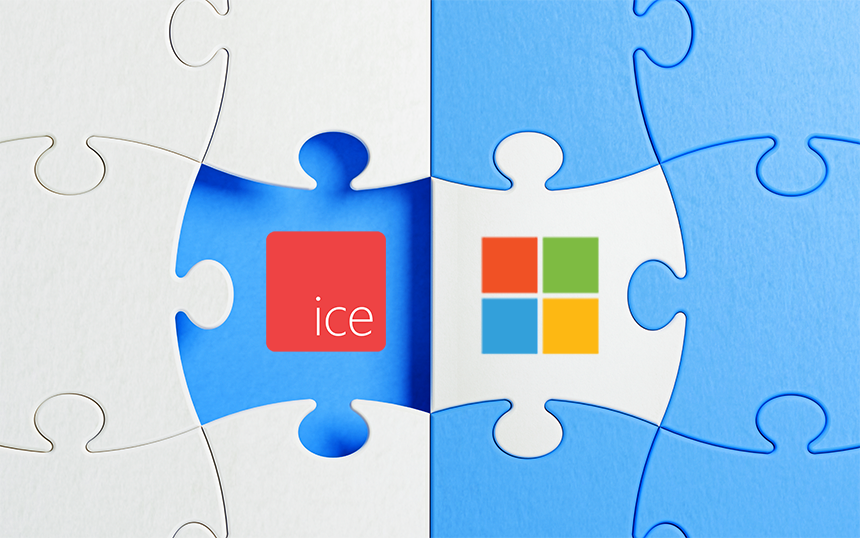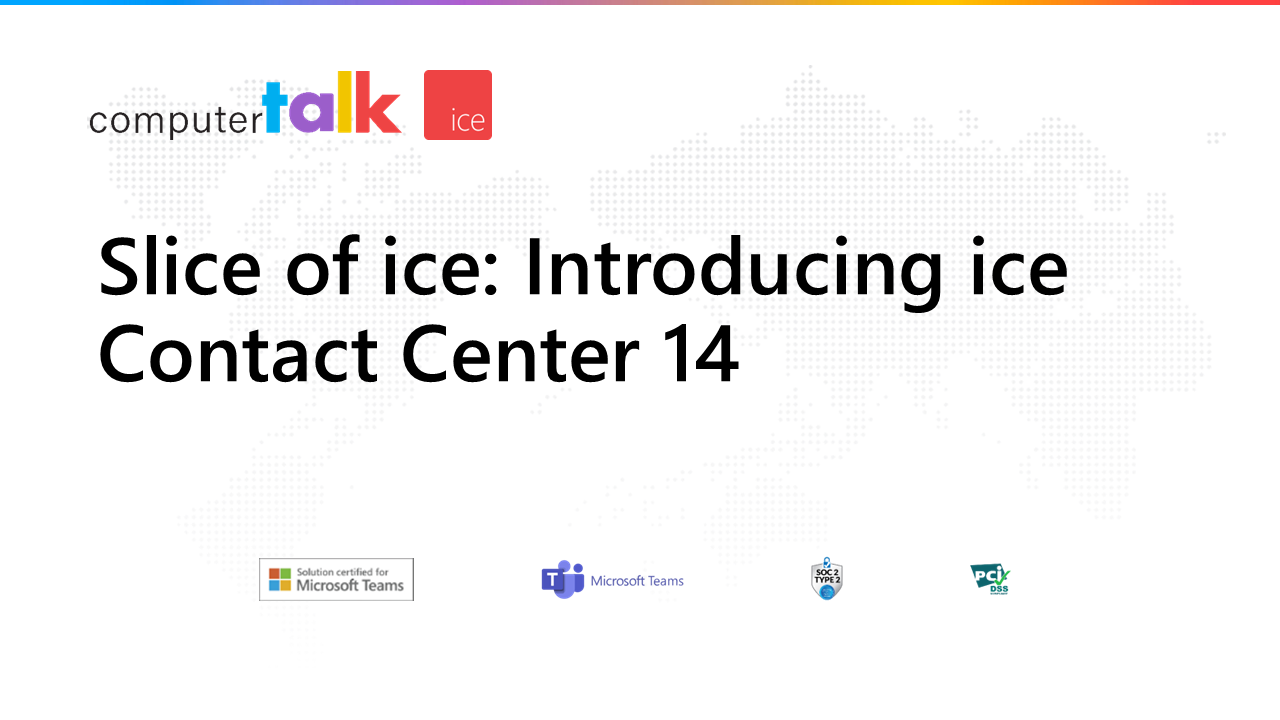Featured
From LCS to Microsoft Teams: The Evolution of ice Contact Center’s Microsoft Integration
by Chris Bardon | Published On November 18, 2021 | Last Updated August 29, 2025

Discover how ComputerTalk’s ice Contact Center evolved alongside Microsoft—from LCS and OCS to Lync, Skype for Business, and Microsoft Teams.
- Two Decades of Microsoft Partnership
- Early Microsoft Speech Server Days
- Bringing Instant Messaging to the Contact Center Space
- From LCS to OCS
- A Potential PBX Replacement
- New Opportunities with UCMA 3.0
- Lync and the Evolution of ice Contact Center
- From Lync to Skype for Business
- The Introduction of Microsoft Teams
Two Decades of Microsoft Partnership
For more than 20 years, ComputerTalk has worked closely with Microsoft to deliver the best contact center integrations for enterprise communication platforms. From integrating with Live Communications Server (LCS) in the early 2000s to achieving Microsoft Teams Contact Center Certification, our journey has been one of innovation, collaboration, and a shared vision for better customer experiences.
Early Microsoft Speech Server Days
ComputerTalk has been visiting and working with the Microsoft Redmond Campus for years. On one such occasion, about 20 years ago, there was a Technology Adoption Program (TAP) event for a new version of a product called Microsoft Speech Server (MSS).
At the time, ComputerTalk was already building a strong Microsoft practice, developing custom speech applications to enhance our contact center solutions. Our interest in MSS grew from a project focused on integrating ice Contact Center with third-party Interactive Voice Response (IVR) systems.
At that event, we spent four days with Microsoft’s product team and gained exclusive insight into the plans for what was supposed to become Speech Server 2007. Over the following years, we worked closely with the Speech Server team, including an in-person ice Contact Center and Speech Server demo in 2006.
Bringing Instant Messaging to The Contact Center Space
Parallel to this, in early 2006, ComputerTalk began exploring ways to bring enterprise instant messaging (IM) into the IT and contact center world. At the time, Live Communications Server (LCS) 2003 had been released, and LCS 2005 had just come out into Microsoft Developer Network (MSDN), billed as an enterprise IM system.
The story goes that Microsoft discovered that customers were using MSN Messenger (or ICQ, AIM, or Yahoo Messenger) for chat inside organizations (including inside Microsoft), so they decided to develop an IT-manageable version of MSN Messenger called Live Communications Server (LCS).
What set Microsoft LCS apart was that it used Session Initiation Protocol (SIP) for instant messaging. SIP was already the standard protocol for Voice over IP (VoIP) signaling and one we had been implementing for ice 6.0. This sparked an idea: could we adapt the chat protocol built for iceChat to work with LCS IM, enabling ice Contact Center to manage instant messaging for internal IT help desks and customer support?
Since there were no documented Application Programming Interfaces (APIs) at the time, our solution was to use Wireshark to read the message capture of an LCS IM session and reverse engineer the whole protocol. This worked surprisingly well, and we rolled IM support into ice Contact Center 6.
From LCS to OCS
As our work with LCS progressed, we started getting invited to preview events for what was being promoted as Office Communications Server (OCS), the next evolution of LCS. Evidently, the LCS product was being rolled into the wider Office server product line, and the limited voice capabilities of OCS (you could make peer-to-peer calls, but it wasn’t very widely used) were being expanded. We already had our IM implementation, but the prospect of leveraging OCS for voice was interesting to us.
Working with early versions of OCS 2007, we successfully routed voice calls from OCS into ice Contact Center and began experimenting with new capabilities like video calling, screen share, and IM to voice elevation. These integrations were possible thanks to our team’s deep expertise in SIP and our flexible SIP stack, which allowed custom manipulation of signaling messages.
At that time, Microsoft used the SIP Requests for Comments (RFCs) more as a suggested starting point than a rule, so interoperating directly with OCS was challenging. It also wasn’t officially supported, yet our SIP interoperability testing demonstrated advanced use cases to Microsoft’s product groups and helped push for more official interoperability support for contact center platforms.
At the time, we had two parallel Microsoft initiatives:
- Microsoft Speech Server — delivering advanced speech-enabled IVRs for ice through its strong development tools and APIs.
- Office Communications Server — building this new collaboration product into something very interesting that we could use for chat, and possibly voice and video as well.
In mid-2006, we received a call from the Microsoft Speech Server product group that changed everything: the long-delayed Speech Server 2007 release wasn’t going to happen, and instead, the technology was going to be rolled into OCS 2007.
A Potential PBX Replacement
For the first time, when OCS 2007 launched, there were a couple of different APIs for it. The Speech Server 2007 components were their own piece, as was the Communicator (client) software development kit (SDK) for custom clients. However, there was also a new Unified Communications Managed API (UCMA) 1.0 that allowed developers to work with the SIP stack, build chatbots, and work with presence. It was pretty clear that the integration efforts would take some time, and Microsoft was also shifting priorities with this product.
OCS 2007 R2: More Than a Minor Release
In early 2008, we started hearing about what would become OCS 2007 R2. While it might’ve looked like a minor release, R2 was pretty significant in what it added to the voice space. It was also the first time you could legitimately replace a PBX with a Microsoft server.
At the time, we were still far from Office 365’s release, and most organizations ran their own set of servers for things like email and chat, along with having a PBX (usually run by a PBX team, not IT) for their corporate phones.
Why OCS Challenged the PBX Market
Now, all of a sudden, there was an option where IT, who was already used to running Microsoft servers, could deploy a server product that offered:
- Dial-in audioconferencing
- Public switched telephone network (PSTN) calling
- Internal chat
- Desktop sharing
- Video calling
In many cases, this started to negate the need for a PBX system (although it would be a few years before Microsoft would start making this claim). Given Microsoft’s track record, this is when we started to wonder whether Microsoft was about to overtake the PBX and “desk phone” market — and how ComputerTalk could align with that shift.
New Opportunities with UCMA 3.0
The Shift from OCS to Lync
While the OCS 2007 R2 release definitely started seeing more adoption, it would be the next release that really changed ComputerTalk. In 2009, we saw the first bits of what would become Lync 2010, and more importantly, UCMA 3.0. This was the convergence where the Speech Server and SIP DNA finally became a single, somewhat cohesive API surface.
Why UCMA 3.0 Mattered
It would allow us to do things like:
- Automate placing and receiving calls.
- Create multiparty conferences.
- Manipulate those conferences at a very low level – changing the programming of the audio mix inside a session.
There was even some great potential for the future, with classes like “AudioVideoCall” promising the ability to handle video in a later release. Clearly, this was a huge step forward for Microsoft and a massive opportunity for ComputerTalk.
Rebuilding ice on UCMA
Previously, the Telephony Interaction Manager (TIM) layer of ice Contact Center relied on Natural Microsystems (NMS) boards to carry out operations like:
- Playing prompts
- Moving calls around in conferences
- Starting recordings
The challenge was that these boards were expensive, proprietary, and not virtualizable, so we had already started looking for alternatives.
When UCMA 3.0 came along, we decided to go all in on Microsoft and rebuild our TIM layer on UCMA. We gained:
- Virtualization-ready SIP/media APIs – eliminating hardware dependencies.
- Deep Microsoft integration – positioning ice as the native contact center for Lync.
- Established solution – instead of building from scratch, we adapted a mature contact center platform into Microsoft’s evolving unified communications world.
Lync and the Evolution of ice Contact Center 7.0
Microsoft Enters the PBX Replacement Market
In late 2010, Lync Server 2010 launched, the first release in which Microsoft claimed to be a PBX replacement. At the time, we were busy working on what would become ice Contact Center 7.0, the most substantial rework of our core product that we’d ever attempted.
Building a Lync-Native Contact Center
Through 2010 and 2011, we continued to work with the product group on refining UCMA and Lync servers into what we’d need to power ice Contact Center. In 2012, three major milestones happened:
- Microsoft released Lync Server 2013, which broke through to even more enterprises.
- ice 7.0 was released as a fully Lync-native contact center product.
- Agents could handle calls and chats within the Lync client.
- A new webchat client connected website users with agents via UCMA through ice.
- Full compatibility was maintained with the powerful workflows customers had already built on ice.
- Microsoft introduced its first Certified Contact Center program—and ComputerTalk was among the first to pass independent certification on Lync 2013.
- We had actually been working with the product group to refine what the certified Contact Center test plan would contain leading up to this.
Pushing Lync to Its Limits
Following the Lync 2013 release, both Microsoft and ComputerTalk started looking at what’s next and refining the releases that were in market as more customers came online. This is where we really started to stretch Lync to its limits, which started a years-long process of optimizing, refactoring, and tuning the way that ice Contact Center and conferencing interact.
We continued to share these learnings with Microsoft, who incorporated our feedback into core Lync features where they could. This included things like:
- Clearing conference metadata out of the fabric.
- Faster conference dial-outs without waiting for direct candidates to time out.
We also adopted new features as they were released. For example, support for Skype Video through ice Contact Center was available in ice the same day as the Skype/Lync interop was announced in 2014.
From Lync to Skype for Business
Microsoft’s Transition from Lync to Skype for Business
In 2014, we started hearing about how the Microsoft acquisition of Skype was going to impact Lync—it went through its fourth name change to Skype for Business Server. ComputerTalk was one of the first applications to receive the Skype for Business 2015 certification with our new ice Contact Center 8.0 release. Momentum was definitely growing in the market for Skype for Business as a PBX.
Cloud Contact Center Momentum
ice Contact Center could integrate with any on-premises infrastructure, but unified communications (UC) in the cloud was finally taking form.
ComputerTalk knows a thing or two about running cloud services. We’d been operating ice Contact Center as a hosted service since we started in 1987, and had always told customers that it was their choice where they’d run ice:
- On-premises in their data center
- Hosted by ComputerTalk in the cloud
By 2015, we were solidly in the cloud services business, and customer-premises equipment (CPE) installs were becoming fewer and farther between. At the same time, we’d been watching this service called BPOS (Business Productivity Online Suite) from Microsoft that was offering items like email as a service. Of course, this would later evolve into Office 365 (and then into Microsoft 365) and offer Skype for Business as a core feature.
Exploring Multitenant Lync Hosting
Between 2012 and 2014, Microsoft encouraged partners to offer multitenant Lync hosting through the Lync Hosting Pack (LHP) initiative to offer Enterprise Voice features that Microsoft wasn’t offering themselves. We investigated this pretty thoroughly since adding Lync as a service to our existing Contact Center as a Service offering was an attractive idea.
This effort involved:
- Collaborating with the Microsoft product group to ensure that the features that ice needed to operate worked well in this new multitenant version of Lync server.
- Working with the independent software vendor partner community to show how ice Contact Center can complement UC as a Service.
In the end, support for LHP wound down pretty quickly, for the most part, because Microsoft started offering a better version of this service themselves as part of Office 365. What did not change, however, was the support we invested in for federation and multi-cloud solutions, where ice Contact Center runs in our cloud, and Skype for Business in another.
Hybrid and Multi-Cloud Contact Center Solutions
Since we always made sure that we had a way to connect an agent to a contact center using only a voice call and a data connection, we could support a hybrid cloud scenario. As Office 365 became dominant, our focus shifted to ensuring that ice Contact Center worked well before, during, and after a migration. While working with the Skype for Business product group, we made sure that voice, chat, and video scenarios all worked with federated Office 365 users, which made the onboarding process much easier from an end-user perspective.
The Introduction of Microsoft Teams
From Skype for Business to Microsoft Teams
In 2017, Microsoft launched a new application called Teams. At first, this was viewed as a third communication platform that wasn’t really email or chat, but as we’d soon find out, there was a much larger plan for this new application.
We’d heard online for a while how unsustainable Skype for Business was. Having some experience with LHP and running our own Skype for Business infrastructure in our cloud, we understood why that was true.
Users needed to be homed on servers, and servers were part of a tenant, so operating at a scale of hundreds of thousands of tenants must have been a nightmare to manage. This means that when we got the early briefing on the plans for Skype for Business to be replaced with Teams, we weren’t really surprised once we saw the architecture diagrams.
Partnering with Microsoft on Teams APIs
We then started to talk with Microsoft’s product team about what the new API layers for Teams would look like and what the “cloud UCMA” would be.
As cloud calling started to come together, we went to the Teams product group (which was a blend of both old and new faces by this point) and discussed what we’ve learned over the last 8-10 years of building on Microsoft Telephony and what we could do together that would be awesome. What we ended up zeroing in on first was how to optimize the agent experience for Teams.
A Teams-Native Contact Center
This collaboration led to the development of iceBar for Teams, a Teams-native contact center endpoint designed to give agents a familiar, optimized interface directly within Teams. We also worked with the TAP team on early release features like Direct Routing to ensure that agents had the fastest and most reliable audio connections to ice.
Leading in Teams Contact Center Certification
Just as we had done with Lync and Skype for Business, ComputerTalk once again pioneered the contact center certification program. We worked closely with the Microsoft team on defining the requirements and became one of the first applications to certify on Teams.
Now – Teams Contact Center Unify Certification
Microsoft Teams Phone Extensibility
In 2025, Microsoft introduced Teams Phone extensibility, opening a new chapter for Microsoft Teams contact center integration. ComputerTalk was proud to be an early adopter, continuing our history of innovation and deep collaboration with Microsoft.
By leveraging Teams Phone extensibility, ice Contact Center customers gain access to enhanced capabilities that simplify and improve contact center operations.
From Direct Connect to Extensibility
Previously, ComputerTalk’s Direct Connect solution allowed organizations to route their Teams phone numbers—whether Microsoft-provided, Direct Routing, or Operator Connect—into ice Contact Center. While powerful, this setup required additional configuration.
With Teams Phone extensibility, the integration is streamlined. The connection between Teams telephony and ice Contact Center remains just as strong, but now the process is far simpler. Businesses can integrate Teams telephony into their contact center faster and with fewer complexities.
Teams Contact Center Unify Certification
Later in 2025, Microsoft announced the Teams Contact Center Unify Certification program. This certification validates solutions built on the Unify integration model—the framework that uses Teams Phone extensibility—to meet Microsoft’s highest standards for quality, reliability, and compatibility.
ComputerTalk is working to become one of the first certified Microsoft Teams contact center solutions under the Unify model. This certification further demonstrates our commitment to delivering a secure, enterprise-grade, and future-proof contact center platform within the Microsoft ecosystem.
What’s Next for Microsoft Teams Contact Centers?
Innovation in Microsoft UC and Collaboration
Looking forward from here, there is certainly a lot going on in the Microsoft UC/Collaboration space to be excited about. Right now, we’re working with pre-release versions of a lot of different Microsoft APIs and coming up with new ways to deliver contact center as a service.
From Infrastructure to Experience
One of our core realizations a few years back was that the underlying tech matters less now than it did in 2011. Back then, having a contact center that would plug into your existing Lync infrastructure, use your SIP trunks and dial plans, and have a common management platform was an important feature.
Now, though, if that contact center is running as a service, the underlying tech doesn’t matter as much as the agent experience, which is why we’re focusing on things like better chat, voice, video, screen share, and collaboration using both Teams and non-Teams clients.
The Future with Microsoft Teams Contact Center
ComputerTalk and Microsoft share a long history of innovation. But the future is even more exciting—with enhanced integrations, smarter workflows, and Teams-native contact center solutions that transform customer experiences.
👉 Interested in learning more? Explore our ice Contact Center for Microsoft Teams or request a demo today to see how we can help your organization elevate customer engagement.
More from our blog
 KPIs provide specific and measurable insights into the performance of your contact center. Learn which essential contact center KPIs to track to boost productivity and enhance the customer experience.
KPIs provide specific and measurable insights into the performance of your contact center. Learn which essential contact center KPIs to track to boost productivity and enhance the customer experience.
 Growing up in the Philippines, back when technology was still evolving, pursuing a career was limited to a few choices: becoming a Doctor, Nurse, Lawyer, Engineer, or Teacher. Growing up, I always knew that I wanted to pursue a career...
Growing up in the Philippines, back when technology was still evolving, pursuing a career was limited to a few choices: becoming a Doctor, Nurse, Lawyer, Engineer, or Teacher. Growing up, I always knew that I wanted to pursue a career...
 On Wednesday, September 11th, ComputerTalk hosted our latest Slice of ice webinar. In this webinar, our Training and Documentation Specialist, Christina Liu, covered the benefits and features in our latest release, ice 14.
On Wednesday, September 11th, ComputerTalk hosted our latest Slice of ice webinar. In this webinar, our Training and Documentation Specialist, Christina Liu, covered the benefits and features in our latest release, ice 14.

